Alabama, nicknamed the Yellowhammer State, is home to 383 mollusk species, 62 mammal species, 73 amphibian species, 93 reptile species, 307 freshwater fish species, and 420 bird species. It is a state rich in fauna.
However, one must consider the species of animals that lived there as well, especially if they’re interested in the state’s natural history. Obviously, we’re referring to animals that went extinct — recently or a long time ago, in the early eras of the earth.
Alabama, for example, doesn’t feature any Precambrian fossils, as its fossil record starts only during the Paleozoic. This was when the state’s mountains were uplifted due to geologic activity.
Most of the state’s known extinct animals are mussels and snails. However, we’ll do our best to introduce you to some prehistoric animals that also lived in Alabama. Let’s discover 9 extinct animals that lived in Alabama!
1. Protostegid Turtles
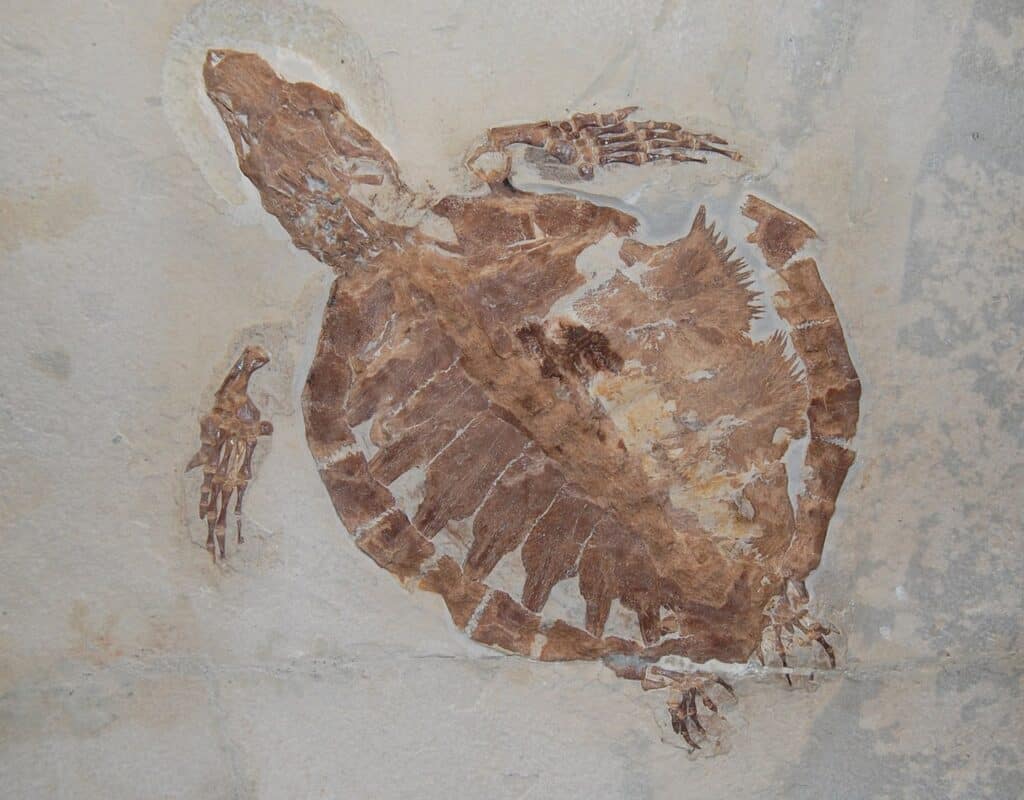
The oldest protostegid turtle specimens date back to the Early Cretaceous period.
©Tommy from Arad / CC BY 2.0 – License
| Protostegid turtles | |
|---|---|
| Kingdom | Animalia |
| Phylum | Chordata |
| Class | Reptilia |
| Order | Testudines |
| Suborder | Cryptodira |
| Clade | Panchelonioidea |
| Family | Protostegidae |
| Species | Protostega gigas |
| Extinct since | Cretaceous-Paleogene extinction event Approx. 66 million years ago |
This family of marine turtles lived in today’s region of Alabama during the Cretaceous. Protostegid turtles were among the largest sea turtles that ever swam the earth. The largest turtle ever documented, Archelon, is a part of this family. Archelon’s head measures 39 inches (1 m).
The oldest protostegid turtle specimens date back to the Early Cretaceous Period. This species went extinct during the Cretaceous-Paleogene eras due to the extinction event. In the Alabama region, protostegid turtles lived in the Mooreville Chalk area and were hunted by Cretoxyrhina mantelli. You’ll find out more about the latter below.
According to phylogenetic analysis, protostegid turtles are related to today’s leatherback sea turtles.
2. Cretoxyrhina mantelli

The largest discovered
Cretoxyrhina mantellitooth is 3 inches long.
©A,Ocram / public domain – License
| Cretoxyrhina mantelli | |
|---|---|
| Kingdom | Animalia |
| Phylum | Chordata |
| Class | Chondrichthyes |
| Superorder | Selachimorpha |
| Order | Lamniformes |
| Family | Cretoxyrhinidae |
| Genus | Cretoxyrhina |
| Species | Cretoxyrhina mantelli |
| Extinct since | Late Cretaceous 107 million to 73 million years ago |
The Cretaceous sharp-nose is a genus of large mackerel sharks that went extinct around 107-73 million years ago. It lived during the Late Albia, Late Campanian, and Late Cretaceous periods. The Alabama region hosted the genus’ type species, Cretoxyrhina mantelli, also known as the Ginsu shark.
This prehistoric shark was more than just a threat. It could grow as long as 26 ft (8 m) and weigh more than 4,866 long tons (4,944 kg). It was among the largest sharks at the time. In Alabama, it lived in the same area as the protostegid turtles: Mooreville Chalk. Protostegid turtle fossils are often marked by the large teeth of this prehistoric shark. The largest discovered Cretoxyrhina mantelli tooth is 3 inches (8 cm) long.
3. Ankylosauria
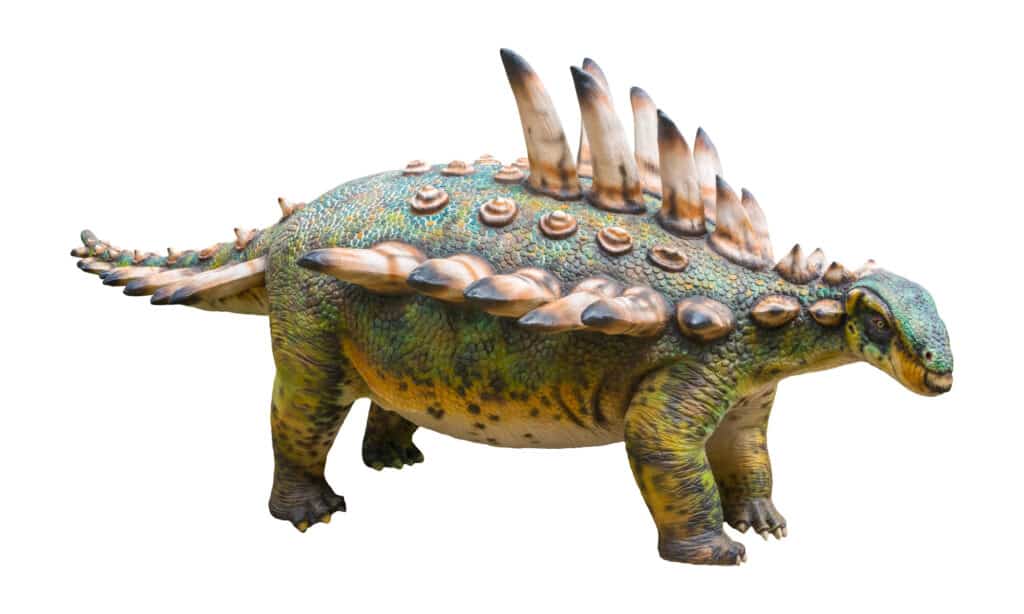
The diet of the Anylosauria group consisted of angiosperms, cycads, and ferns.
©YuRi Photolife/Shutterstock.com
| Ankylosauria | |
|---|---|
| Kingdom | Animalia |
| Phylum | Chordata |
| Clade | Dinosauria |
| Order | Ornithischia |
| Clade | Thyreophora |
| Clade | Eurypoda |
| Suborder | Ankylosauria |
| Extinct since | Late Cretaceous Period |
Ankylosauria are armored dinosaurs that used to inhabit the Alabama region from the Middle Jurassic period up until the end of the Cretaceous Period. Since a great part of Alabama was covered by seawater, these dinosaurs were common in the state’s subtropical forests.
The dinosaurs in this group featured armor similar to turtle shells and had short limbs. Ankylosauria are part of the same group as the well-known stegosaurs, Thyreophora. They were quite similar to turtles, having a low build. They could feed only on vegetation shorter than 39 inches (1 m) high.
The diet of the Anylosauria group consisted of angiosperms, cycads, and ferns.
4. Hadrosaurids
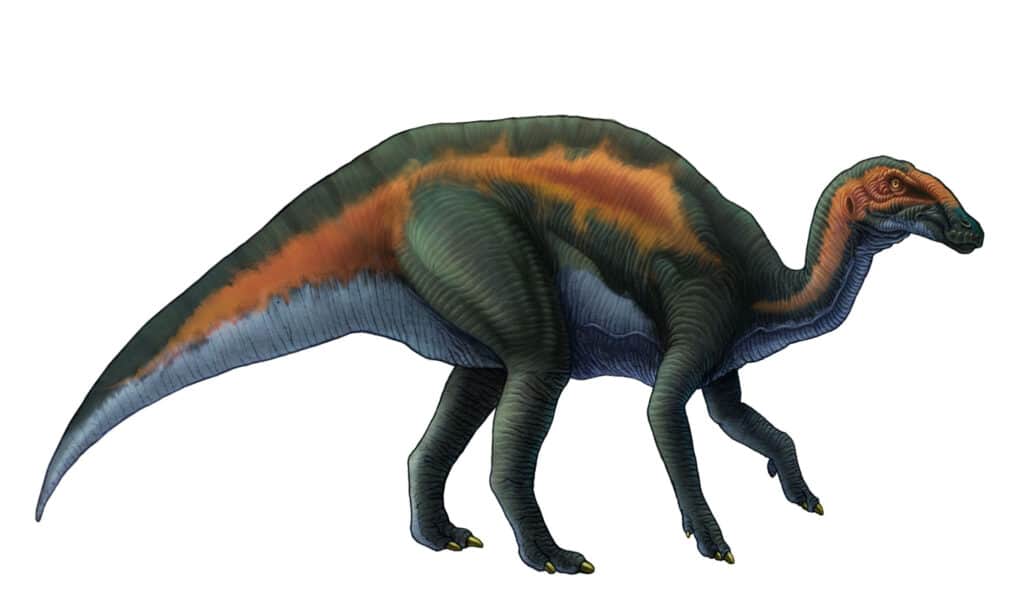
Hadrosauridae is a family of dinosaurs that inhabited the subtropical forests of the prehistoric Alabama region.
©Bee_acg/Shutterstock.com
| Hadrosaurids | |
|---|---|
| Kingdom | Animalia |
| Phylum | Chordata |
| Clade | Dinosauria |
| Order | Ornithischia |
| Clade | Ornithopoda |
| Clade | Hadrosauromorpha |
| Family | Hadrosauridae |
| Type species | Hadrosaurus foulkii |
| Extinct since | Late Cretaceous Period |
Hadrosauridae is a family of dinosaurs that inhabited the subtropical forests of the prehistoric Alabama region. They are known as duck-billed dinosaurs, but not because they had bills. Instead, their snout bones had a duck-bill appearance. This dinosaur family was one of North America’s most dominant herbivore families during the Late Cretaceous period.
An interesting fact about hadrosaurids is that they were facultative bipeds. Adults walked mostly on four legs (but alternated), while young dinosaurs walked mostly on two legs.
The first hadrosaurid fossils were discovered near the Judith River in North America. This species, like many others, went extinct in the Late Cretaceous Period.
5. Megatherium – Giant Ground Sloth
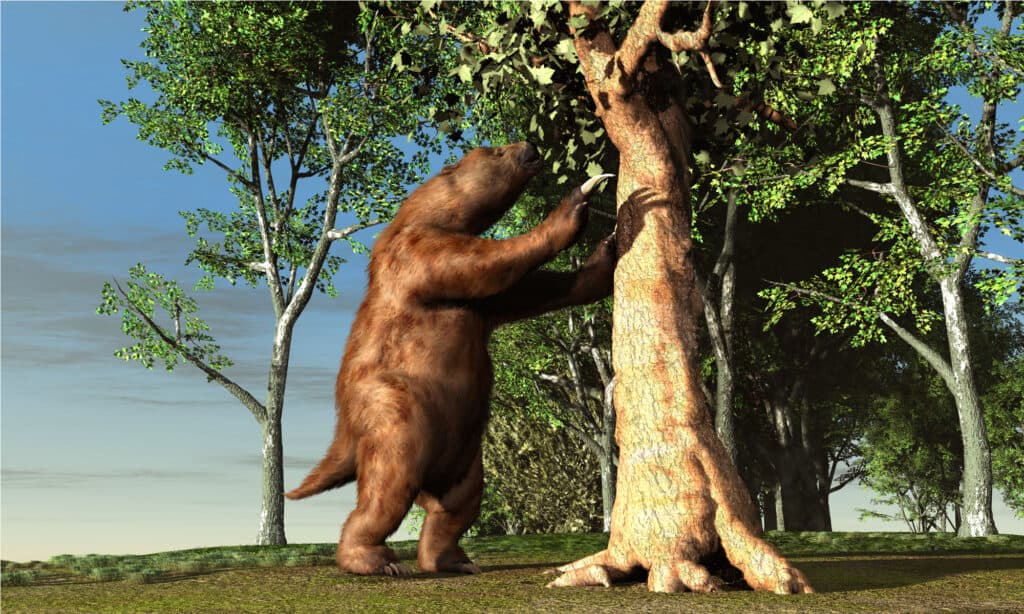
Giant ground sloths, also known as megatherium, were native to South and North America.
©Esteban De Armas/Shutterstock.com
| Megatherium – Giant Ground Sloth | |
|---|---|
| Kingdom | Animalia |
| Phylum | Chordata |
| Class | Mammalia |
| Order | Pilosa |
| Clade | Megatheria |
| Family | Megatheriidae |
| Subfamily | Megatheriinae |
| Genus | Megatherium |
| Type species | Megatherium americanum |
| Extinct since | Late Pleistocene period 12,000 years ago |
The southern part of Alabama was home to mastodons, mammoths, and giant ground sloths. This area was fit for these species due to the increased variety of trees, grassland areas, and large forests. The giant ground sloths, also known as megatherium, are native to South and North America. They were some of the largest mammals to live at the time.
A megatherium could grow as high as 20 ft (6m) and weigh up to 8,800 lbs (4 tons). The species is not as old as some may think. It used to inhabit the Alabama region around 10,000 years ago. It went extinct during the settlement of the Americas event, which marks the hunting of megatherium done by hunter-gatherers of the Paleolithic era.
6. Bigmouth Rocksnail
| Bigmouth rocksnail | |
|---|---|
| Kingdom | Animalia |
| Phylum | Mollusca |
| Class | Gastropoda |
| Clade | Caenogastropoda |
| Clade | Sorbeoconcha |
| Superfamily | Cerithioidea |
| Family | Pleuroceridae |
| Genus | Leptoxis |
| Subspecies | Leptoxis occultata |
Leptoxis occultata, commonly known as the bigmouth rocksnail, was a freshwater snail species endemic to the US. It featured a gill and an operculum and is one of the many species of aquatic gastropod mollusk that went extinct — not only in America but worldwide.
Most snails and mollusk species became extinct in recent years rather than in prehistoric periods. This is caused mainly by pollution and by the lack of conservation measures.
The family of the bigmouth rocksnail, Pleuroceridae, is endemic to the eastern freshwaters of North America. Pleuroceridae require unpolluted rivers or streams to thrive. There are few to no species in this family adapted to living in reservoirs or lakes.
7. Olive marstonia
| Olive marstonia | |
|---|---|
| Kingdom | Animalia |
| Phylum | Mollusca |
| Class | Gastropoda |
| Clade | Caenogastropoda |
| Clade | Hypsogastropoda |
| Clade | Littorinimorpha |
| Superfamily | Rissooidea |
| Family | Hydrobiidae |
| Subfamily | Nymphophilinae |
| Genus | Marstonia |
| Species | Marstonia olivacea |
| Living Period | Fossils date to Early Carboniferous period 358.9 million to 323.2 million years ago |
Olive marstonia, scientifically known as marstonia olivacea, was a freshwater snail species that used to inhabit only the waters of Alabama as it was endemic to this state. Unlike the bigmouth rocksnail, olive marstonia is part of the Hydrobiidae family.
The Hydrobiidae family consists of very small snails, commonly referred to as mud snails. They live in brackish and freshwater and can be found worldwide. Subfamilies and genera can be endemic to certain areas, as shown by the olive marstonia.
This family’s oldest fossils date back to the Early Carboniferous period 358.9 million to 323.2 million years ago.
8. Shoal Sprite

The shoal sprite’s scientific name is
Amphigyra alabamensis.
©Henry Augustus Pilsbry (1862-1957, U.S.A.) / public domain – License
| Shoal sprite | |
|---|---|
| Kingdom | Animalia |
| Phylum | Mollusca |
| Class | Gastropoda |
| Clade | Heterobranchia |
| Clade | Euthyneura |
| Clade | Panpulmonata |
| Clade | Hygrophila |
| Superfamily | Planorboidea |
| Family | Planorbidae |
| Genus | Amphigyra |
| Species | Amphigyra alabamensis |
| Living Period | Unknown |
Another species endemic to Alabama is the shoal sprite. These were freshwater snails that could also breathe air. As such, they are referred to as aquatic pulmonate gastropod mollusks. They are a part of the Planorbidae family, commonly referred to as the Ram’s Horn snails, due to their shell shape and aspect.
The shoal sprite’s scientific name is Amphigyra alabamensis, showcasing its home region. The family of this snail is characterized by blood containing copper-based hemocyanin. This allows the snails to breathe oxygen efficiently and gives their bodies a reddish color.
The extinction period or range of this species is not known. This is the case for many mollusks, snails, and gastropods worldwide.
9. Basilosaurus
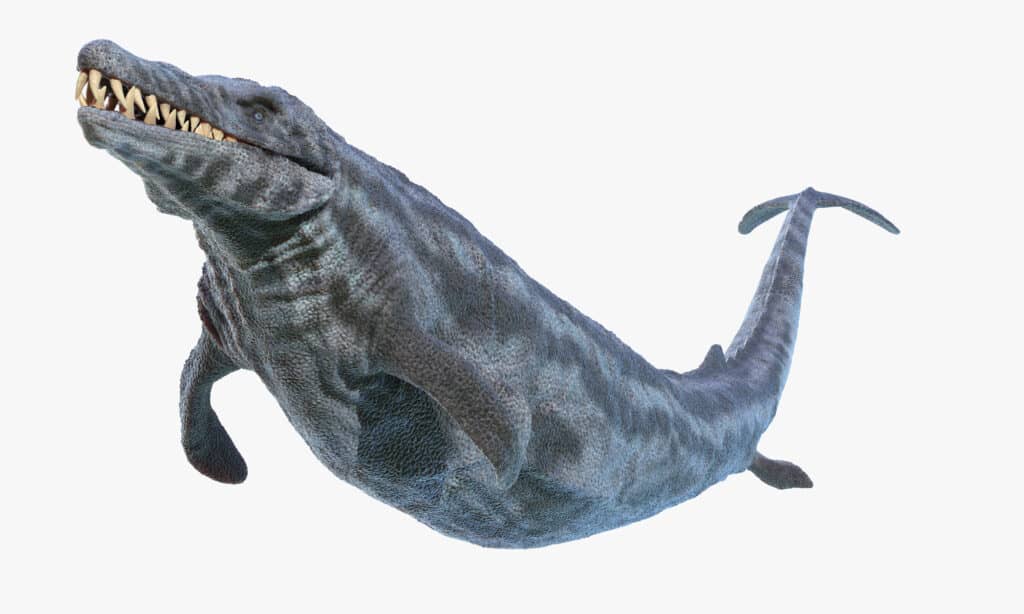
The average length of a
Basilosauruswas around 49 to 66 feet.
©SciePro/Shutterstock.com
| Basilosaurus | |
|---|---|
| Kingdom | Animalia |
| Phylum | Chordata |
| Class | Mammalia |
| Order | Artiodactyla |
| Infraorder | Cetacea |
| Family | Basilosauridae |
| Subfamily | Basilosaurinae |
| Genus | Basilosaurus |
| Species | Basilosaurus cetoides Basilosaurus isis |
| Extinct since | Late Paleogene Period 33.9 million years ago |
The king lizard must be mentioned in this list. Basilosaurus is a genus of large whale that lived in Alabama around 41.3 million to 33.9 million years ago. It lived during the Tertiary geologic period, which began right after the Cretaceous-Paleogene extinction event.
The average length of a Basilosaurus was around 49 to 66 ft (15-20m). This makes the species one of the largest after the extinction event. Basilosaurus is a species of prehistoric whale, making the approximate translation of king lizard sound a bit off. This is due to the initial naming of the B. cetoides fossils discovered in Alabama. The rules of zoological nomenclature state that the original given name must be used.
Basilosaurus had to be mentioned as it is the state fossil of Alabama (and Mississippi). This is partly because a large number of B. cetoides fossils were discovered there. In fact, these fossils were once so common that they were used as furniture.
Summary of 9 Extinct Animals That Lived in Alabama
Here’s a recap of 9 extinct animals that once inhabited the state of Alabama:
| Number | Animal | Extinction Date |
|---|---|---|
| 1 | Protostegid Turtles | Cretaceous-Paleogene extinction event: About 66 million years ago |
| 2 | Cretoxyrhina mantelli | Late Cretaceous period: 107 million to 73 million years ago |
| 3 | Ankylosauria | Late Cretaceous period |
| 4 | Hadrosaurids | Late Cretaceous period |
| 5 | Megatherium – Giant Ground Sloth | Late Pleistocene period: 12,000 years ago |
| 6 | Bigmouth Rocksnail | Unknown |
| 7 | Olive marstonia | Fossils date to the Early Carboniferous period: 358.9 million to 323.2 million years ago |
| 8 | Shoal Sprite | Unknown |
| 9 | Basilosaurus | Late Paleogene period: 33.9 million years ago |
The photo featured at the top of this post is © Esteban De Armas/Shutterstock.com
Thank you for reading! Have some feedback for us? Contact the AZ Animals editorial team.






